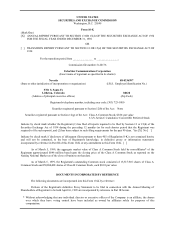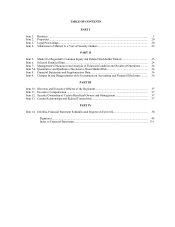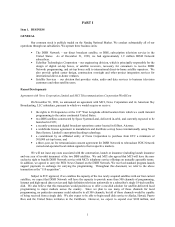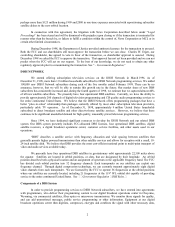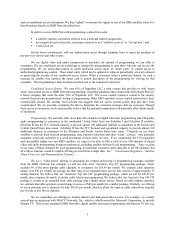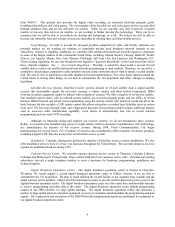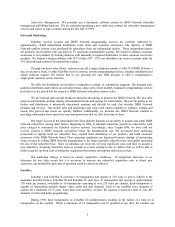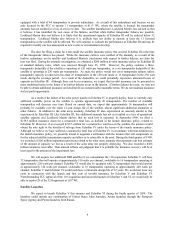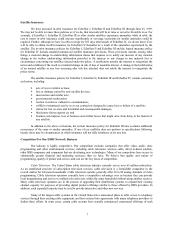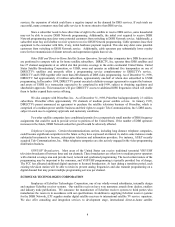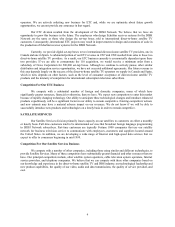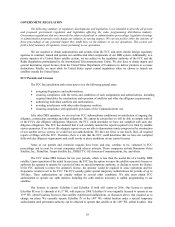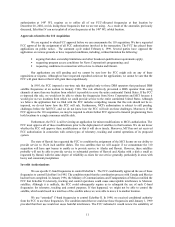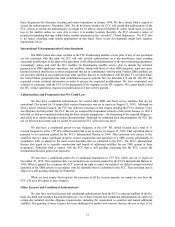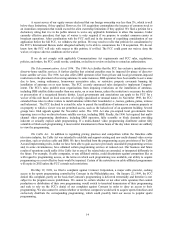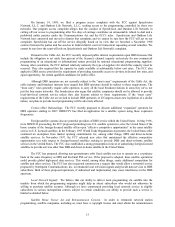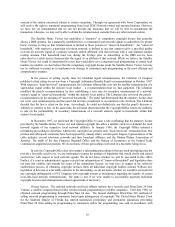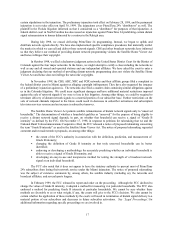Dish Network 1998 Annual Report Download - page 9
Download and view the complete annual report
Please find page 9 of the 1998 Dish Network annual report below. You can navigate through the pages in the report by either clicking on the pages listed below, or by using the keyword search tool below to find specific information within the annual report.7
Satellite Insurance
We have procured in-orbit insurance for EchoStar I, EchoStar II and EchoStar III through June 25, 1999.
We may not be able to renew these policies or, if we do, that renewals will be at rates or on terms favorable to us. For
example, if EchoStar I, EchoStar II, EchoStar III or other similar satellites experience anomalies while in orbit, the
cost to renew in-orbit insurance could increase significantly or coverage exclusions for similar anomalies could be
required. Further, although we have in-orbit coverage for 365 days after launch of EchoStar IV, we do not know if we
will be able to obtain in-orbit insurance for EchoStar IV thereafter as a result of the anomalies experienced by the
satellite. The in-orbit insurance policies for EchoStar I, EchoStar II and EchoStar III and the launch insurance policy
for EchoStar IV include standard commercial satellite insurance provisions. These provisions include, among other
things, a material change in underwriting information clause that requires us to notify our insurers of any material
change in the written underwriting information provided to the insurers or any change in any material fact or
circumstance concerning our satellites insured under the policy. A notification permits the insurers to renegotiate the
terms and conditions if the result is a material change in risk of loss or insurable interest. A change in the health status
of an insured satellite or any loss occurring after risk has attached does not entitle the insurers to renegotiate the
policy terms.
The satellite insurance policies for EchoStar I, EchoStar II, EchoStar III and EchoStar IV contain customary
exclusions, including:
• acts of war or similar actions;
• loss or damage caused by anti-satellite devices;
• insurrection and similar acts;
• governmental confiscation;
• nuclear reaction or radioactive contamination;
• willful or intentional acts by us or our contractors designed to cause loss or failure of a satellite;
• claims for lost revenue and incidental and consequential damages;
• third-party claims against us; and
• business interruption, loss of business and similar losses that might arise from delay in the launch of
any satellite.
In addition to the above exclusions, the current insurance policy for EchoStar III also excludes additional
occurrences of the same or similar anomalies. If one of our satellites does not perform to specifications following
launch, there may be circumstances in which insurance will not fully reimburse us for any loss.
Competition For Our DISH Network Business
Our industry is highly competitive. Our competition includes companies that offer video, audio, data,
programming and other entertainment services, including cable television, wireless cable, direct-to-home satellite,
other DBS companies and companies that are developing new technologies. Many of our competitors have access to
substantially greater financial and marketing resources than we have. We believe that quality and variety of
programming, quality of picture and service, and cost are the key bases of competition.
Cable Television. The United States cable television industry currently serves over 65 million subscribers.
As an established provider of subscription television services, cable television is a formidable competitor in the
overall market for television households. Cable television systems generally offer 30 to 80 analog channels of video
programming. Cable television operators currently have a competitive advantage over us because they can provide
local programming and service to multiple television sets within the same household without using another receiver.
Many cable television operators are in the process of upgrading their distribution systems to expand their existing
channel capacity for purposes of providing digital product offerings similar to those offered by DBS providers. In
addition, such expanded capacity may be used to provide interactive and other new services.
Many of the largest cable systems in the United States have announced plans to offer access to telephony
services through their existing cable equipment, and have entered into agreements with major telephony providers to
further these efforts. In some cases, certain cable systems have actually commenced commercial offerings of such

